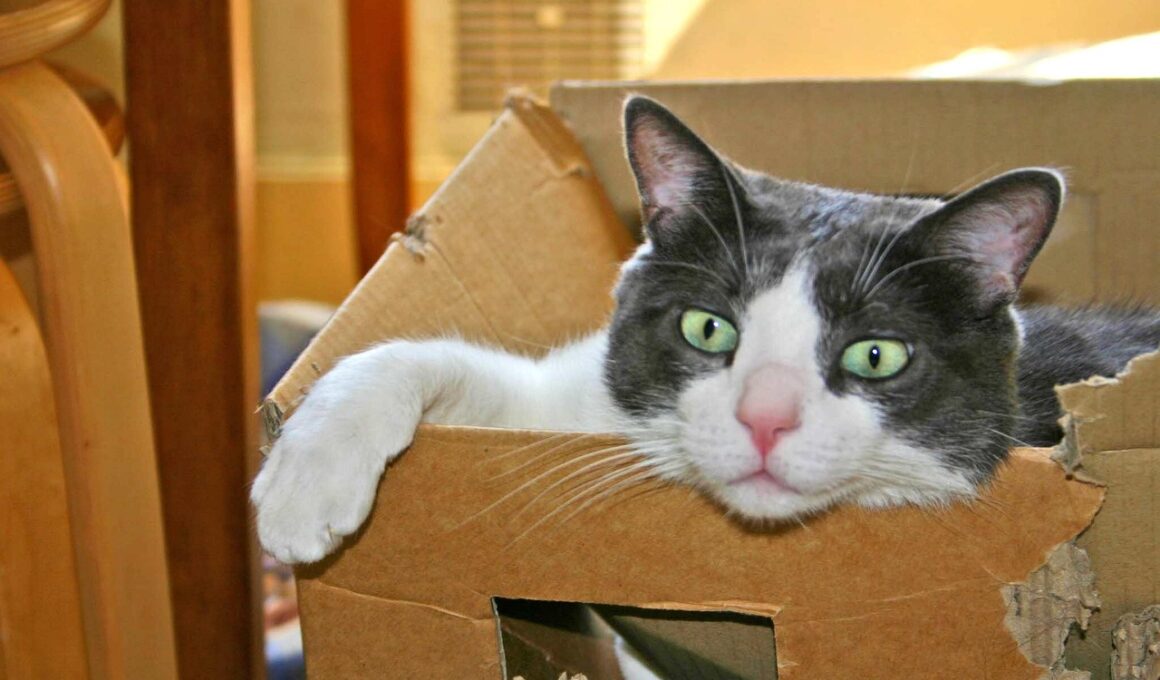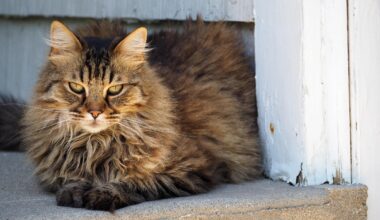DIY Cat House: Using Cardboard Safely and Effectively
Creating a cat house can be an enjoyable project that allows you to express creativity while ensuring your feline friend enjoys a comfortable home. Cardboard is an excellent choice for this project due to its accessibility, affordability, and versatility. Not only is it lightweight, but it is also easy to cut and shape into various forms suitable for a cozy cat environment. Proper safety precautions should, however, be taken while working with cardboard. One key step is to use non-toxic adhesives and paints to prevent harmful emissions or toxic exposure to your pet. Using cardboard allows you to easily create different sections within the house such as sleeping areas or play zones. This way, you ensure your cat remains engaged and happy in their new dwelling. Remember, ventilation is crucial, so including small openings for air circulation enhances comfort. Consider adding removable cardboard panels for easy cleaning. Overall, a DIY cardboard cat house is a simple yet effective solution that promotes safety, warmth, and creativity for both you and your beloved cat without breaking the bank.
The first step in constructing your DIY cardboard cat house is gathering all the necessary materials. You will need multiple sheets of sturdy cardboard, as well as tools such as a utility knife or scissors for cutting. Additionally, having a ruler and pencil will enable you to create accurate measurements. Consider using high-quality cardboard, such as from old moving boxes, since this material offers excellent structural integrity. Before starting, arrange your workspace for a clean environment, ensuring safe operation of tools. Collect non-toxic glue and tape, as well as optional decorative items like fabric or paint to personalize your cat house. Setting up a clear plan is crucial: sketch a design detailing dimensions, entrance sizes, and space for windows. Think about features that can enhance your cat’s experience, such as perches or tunnels. Highlighting the house’s structure helps you visualize the assembly process. Always prioritize your cat’s size and preferences while designing, as different breeds have varying needs. Also, consider that some cats prefer small, enclosed spaces, while others enjoy open areas. Keeping these factors in mind will ensure you create a perfect retreat for your furry companion!
Constructing the Cat House
Once you have the materials ready and the design planned out, it’s time to begin the construction of your cat house. Start by measuring and cutting the cardboard according to the dimensions outlined in your design. Focus on creating sturdy walls and a well-fitted roof, which provides shelter and security for your kitty. Using a utility knife allows for clean cuts, and be sure to follow basic safety rules to avoid injuries while cutting. Once the pieces are cut, assemble the walls first using non-toxic glue, ensuring they fit snugly together. It’s wise to allow the glue to dry thoroughly before proceeding. Next, attach the roof panels. Ensure that the design includes entrances and exits so your pet can easily enter and exit the house. Consider reinforcing the seams and connections with tape for added strength, particularly if your cat is an avid climber or scratcher. Lastly, personalizing the house can also add aesthetic appeal while contributing to your cat’s enjoyment, so feel free to add decorative touches, including painting or fabric covering, to suit your cat’s sense of style and comfort!
Safety is paramount when creating a cat house from cardboard; thus, keeping your pet’s wellbeing in mind during the entire process is essential. Be vigilant about eliminating potential hazards, such as sharp edges that could injure curious paws or mouths. When cutting cardboard, use a utility knife and exercise caution, ensuring to work gently without applying too much pressure. Always supervise your pet while the cat house is still being constructed, especially if you’re utilizing items like glue or paint. Non-toxic products are vital to safeguarding your cat’s health, as ingestion could lead to serious issues. Also, periodically check the durability and integrity of the cardboard, particularly if your house endures heavy use. Over time, the material may wear down, necessitating reinforcement or replacement. Regular inspections will help maintain a safe living environment. Additionally, creating sections within the house offers your cat choices, giving them the freedom to explore their space safely and reduce the chances of boredom in one area. By following these guidelines, you can create a durable and enjoyable environment for your furry friend.
Accessorizing Your Cat House
Adding accessories to your DIY cat house can significantly enhance your pet’s experience, making it even more comfortable and stimulating. You might consider including soft bedding materials like old blankets or pillows to give your cat a cozy place to rest. Cats love warmth and security, so providing a well-padded area will encourage them to use the house consistently. Another fun idea is to incorporate small toys or scratching posts within the house. This addition can help satisfy your cat’s natural instincts to scratch and play. Additionally, consider adding removable and washable mats, as they can help keep the house cleaner and fresher over time. Other enhancements might include attaching small catnip pouches to encourage play. Furthermore, if you opt to create different sections, introducing interactive elements like tunnels or hiding spots can boost mental stimulation. It’s also beneficial to rotate these accessories periodically to maintain your cat’s interest and engagement. Ensure that any additions align with your cat’s personality and preferences, ensuring that what you create truly meets their needs. Engaging your cat in this manner can transform their new cardboard home into a beloved sanctuary they cherish!
Creating a DIY cardboard cat house presents numerous learning opportunities for both you and your cat. Allow your cat to observe the construction process while ensuring their curiosity doesn’t lead to unsafe situations. This engagement not only helps them feel involved but also enables them to explore their new environment as it forms. Teach your cat through interaction the importance of safe play and boundaries within the house. After completion, encourage your cat to explore their new abode slowly. You’ll likely find your cat excitedly investigating the different sections you’ve created. Use treats or toys to entice them inside, creating positive associations with their new home. This also provides a chance to observe their preferences when it comes to space and exploration. Once they are comfortable, monitor how they interact with the accessories you’ve included. Keeping your cat engaged and comfortable in their new home will lead to lasting bonds and their overall happiness. Document the construction process and the initial reactions; they could become delightful memories. Ultimately, constructing a cat house serves not only as enrichment for your kitty but is also a fulfilling project for you!
Conclusion and Reflection
In conclusion, building a DIY cardboard cat house is an enriching experience that promotes creativity and provides your cat with a safe, engaging space. By using safe materials and including stimulating features, you cater to your cat’s natural instincts. Prioritizing safety is essential at every step, from construction through to interaction. As you design and build your cardboard cat house, remember to incorporate factors that meet both your aesthetic choices and your pet’s needs. You will not only create a unique dwelling for your furry friend, but earlier engagement in monitoring their happiness helps strengthen your bond. Regularly inspect the house to ensure it remains a safe place, reinforcing areas needing improvement over time. In addition, delight in the joy of observing your cat enjoying their new environment; their happiness will reflect your efforts. Engaging in DIY projects such as this fosters a sense of fulfillment while encouraging creativity and customization. Overall, a cardboard cat house can provide lasting comfort for your cat while delivering an enjoyable project for you to undertake as a cat owner.
Ultimately, your DIY cat house journey is bound to strengthen the bond you share with your feline companion. As you embark on this creative endeavor, always keep your cat’s preferences in mind. Engaging them in this process and making adjustments based on their reactions can lead to a more tailored experience that acknowledges their individuality. Celebrating their presence while ensuring safety is critical to the success of your project. Remember that the joy your cat experiences in their new cardboard house will reflect the love and care you’ve put into creating it. Taking the time to engage with your cat during the construction can be a rewarding shared experience, leading to warmer connections. Crafting such spaces also contributes to their overall enrichment, directly influencing their behavior and satisfaction. Although you may face challenges during construction, persistence and creativity are keys. Conclude by basking in the joy of seeing your cat relish the comfort of your handcrafted masterpiece. The effort involved not only results in a fun house but will also lead to countless hours of enjoyment for your beloved pet. Enjoy this meaningful project as it evolves!


